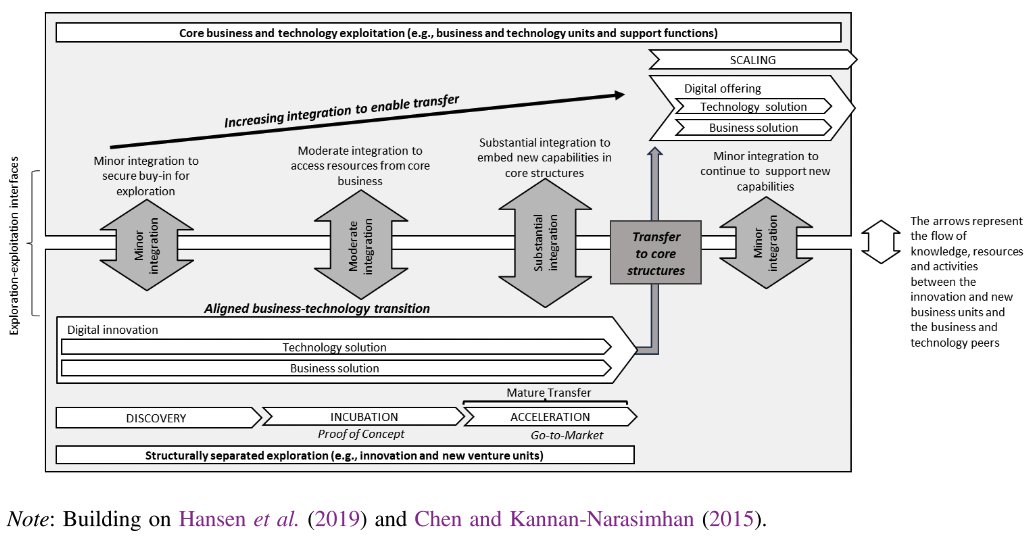Tackling the Internal Transition to Scale of Digital Innovations
Aiming at being more effective and efficient in exploring digital innovations and new digital business ideas, incumbent firms have adopted separated structures such as innovation units, new business units, internal incubators and accelerators, digital labs, etc. While these structures have been successful in spurring new initiatives, they have not as effective in bringing these to scale. Part of the challenge is the need to transfer the new digital offerings, processes and models to core business and technology structures suitable for operationalising and/or commercialising these at scale – in other words, activities to explore new ideas in separated structures need to transition to become exploitative activities in core business and technology structures. This process, however, is far from simple as core business and technology structures are not naturally equipped with the needed capabilities and resources and its structures practices are often compatible with new digital solutions.
In a recent publication, I aimed at tackling this challenge by embarking on a journey to dissect the transition to scale of eight digital service innovations developed in a large Asian incumbent bank. This exploration, detailed in the International Journal of Innovation Management, pivots around the intricate dance of transitioning digital innovations from their development in the Bank’s innovation unit to full-scale operationalisation and/or commercialisation in core business structures, with a focus on understanding the practices and challenges of enabling an aligned business-technology transition of digital innovations.
Here, I present the essence of our findings and their implications for both academic research and industry practice:
Key Highlights:
- Introduction of a Dual Transition-to-Scale Model: We describe a nuanced framework that delineates the variegated intensities of integration, characterised by the flow of knowledge and resources between exploration and exploitation structures, required for digital innovations to seamlessly transition into scalable solutions. This model, described by innovation managers, focusses on manipulating the degree of integration to secure buy-in for the innovation, access core assets from business and technology peers, and embed new capabilities and resources in core structures to able the transfer of innovations to core business and technology actors.
 Illustration 1. Aligned business-technology transition of DI with integration and transfer
Illustration 1. Aligned business-technology transition of DI with integration and transfer
- Diverse Project Scaling Trajectories: We outline three distinct scenarios of project scaling journeys, offering a granular view into the strategic integration and transition tactics pivotal for digital innovation scalability. In this, we describe how innovation managers deviate from the model that they describe by taking actions to cope with the challenges of pursuing digital innovation in an organisation still undergoing digital transformation. These coping actions, although aimed at creating the enabling conditions for innovations to transition, also created a disconnect between the business and technology transition of digital transformation, creating transition challenges at a later stage.
Contributions to Academic Research:
Our study enriches the academic investigation by presenting a model of how innovation managers expect to enable an aligned business-technology transition to scale and showing that integration and transfer decisions along the innovation process significantly impact the business-technology transition of digital innovations and, thus, need to be carefully managed to avoid misalignment.
Contributions to Practice:
For practitioners, this study offers actionable insights to orchestrate the scaling process effectively, ensuring that digital innovations are not only developed but also successfully operationalised and/or commercialised to achieve their full market potential. Innovation managers should be aware of their role in transition and of how their decisions around integration could affect transfer in the later stages. They should be careful not to create a disconnect between business and technology transition, which could have consequences not only for the scaling of the digital innovation but also for exploitation in the organisation.
With this study, we aimed at expanding the scientific investigation into exploration-exploitation of digital innovations in the context of digital transformation. Yet, much remains to be understood and explored. In particular, how the orchestration of internal transition to scale might be effectively and efficiently aligned with go-to-market offers a promising area of investigation as innovation managers face the significant challenge of pursuing commercial success while needed to navigate the complex corporate environment. In short, companies need to be better in enabling internal transition and research has much to contribute.


Add a Comment